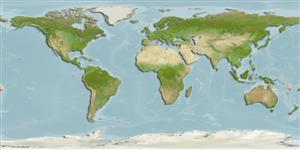>
Ophidiiformes (Cusk eels) >
Dinematichthyidae (Viviparous brotula)
Etymology: Dermatopsis: Greek, derma = skin + Greek, opsis = appearance (Ref. 45335); greenfieldi: Named for David. W. Greenfield, Moss Landing Marine Lab, USA.
Eponymy: Dr David Wayne Greenfield (d: 1940) is an ichthyologist, marine biologist, zoogeographer and ecologist who is now a Research Associate at the California Academy of Sciences. [...] (Ref. 128868), visit book page.
More on authors: Møller & Schwarzhans.
Environment: milieu / climate zone / depth range / distribution range
Ecologia
marinhas associadas(os) a recifes; intervalo de profundidade 1 - 10 m (Ref. 57886). Tropical
Central Pacific: Fiji.
Tamanho / Peso / Idade
Maturity: Lm ? range ? - ? cm
Max length : 5.3 cm SL (female)
Descrição suscinta
Chaves de identificação | Morfologia | Morfometria
Raios dorsais (total) : 64 - 70; Raios anais : 44 - 49; Vértebras: 39 - 41. This species is characterized by the following: vertebrae 11-12 + 27-29 = 39-41, dorsal fin rays 64-70, anal fin rays 44-49; body with scales; eye 1.8-2.6 % SL, sharp spine on ventral maxilla positioned behind rear tip of eye; otolith with pointed posterior tip and weak postdorsal angle, it is elongate, length to height ratio 2.1-2.2, sulcus with separated colliculi (Ref. 57886); large, broad single pair of (outer) pseudoclaspers, inwardly connected to isthmus with ligament, and has 2 supporters, the anterior inclined, short, joined at base to massive and long posterior supporter (Ref. 76869).
Ciclo de vida ou comportamento de acasalamento
Maturidade | Reprodução | Desova | Ovos | Fecundidade | Larvas
Møller, P.R. and W. Schwarzhans, 2006. Review of the Dinematichthyini (Teleostei, Bythitidae) of the Indo-west Pacific, Part II. Dermatopsis, Dermatopsoides and Dipulus with description of six new species. The Beagle 22:39-76. (Ref. 57886)
Status na Lista Vermelha da UICN (Ref. 130435: Version 2024-2)
Ameaça para os humanos
Harmless
Uso pelos humanos
Ferramentas
Relatórios especiais
Baixar XML
Fontes da internet
Estimates based on models
Preferred temperature (Ref.
123201): 26.8 - 29.3, mean 28 °C (based on 247 cells).
Índice de diversidade filogenética (Ref.
82804): PD
50 = 0.5312 [Uniqueness, from 0.5 = low to 2.0 = high].
Bayesian length-weight: a=0.00389 (0.00180 - 0.00842), b=3.12 (2.94 - 3.30), in cm total length, based on all LWR estimates for this body shape (Ref.
93245).
Nível Trófico (Ref.
69278): 3.2 ±0.5 se; based on size and trophs of closest relatives
Fishing Vulnerability (Ref.
59153): Low vulnerability (10 of 100).
